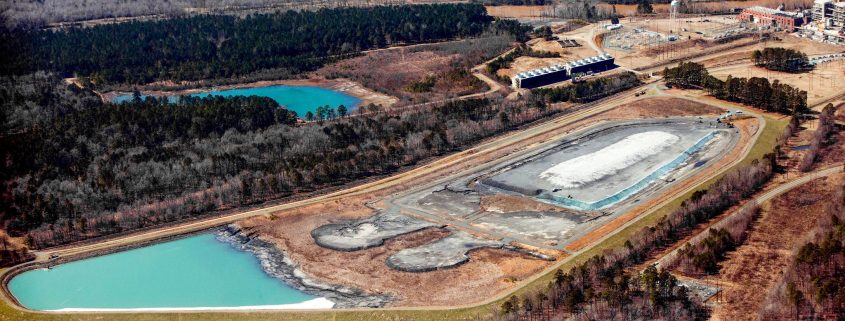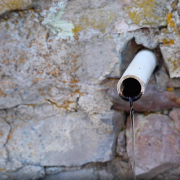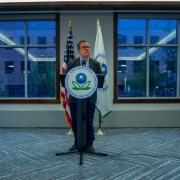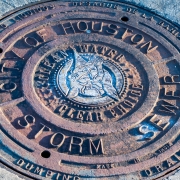U.S. Courts Issue Contradictory Rulings on Groundwater and the Clean Water Act
Courts grapple with pollution cases that pit the law against nature.
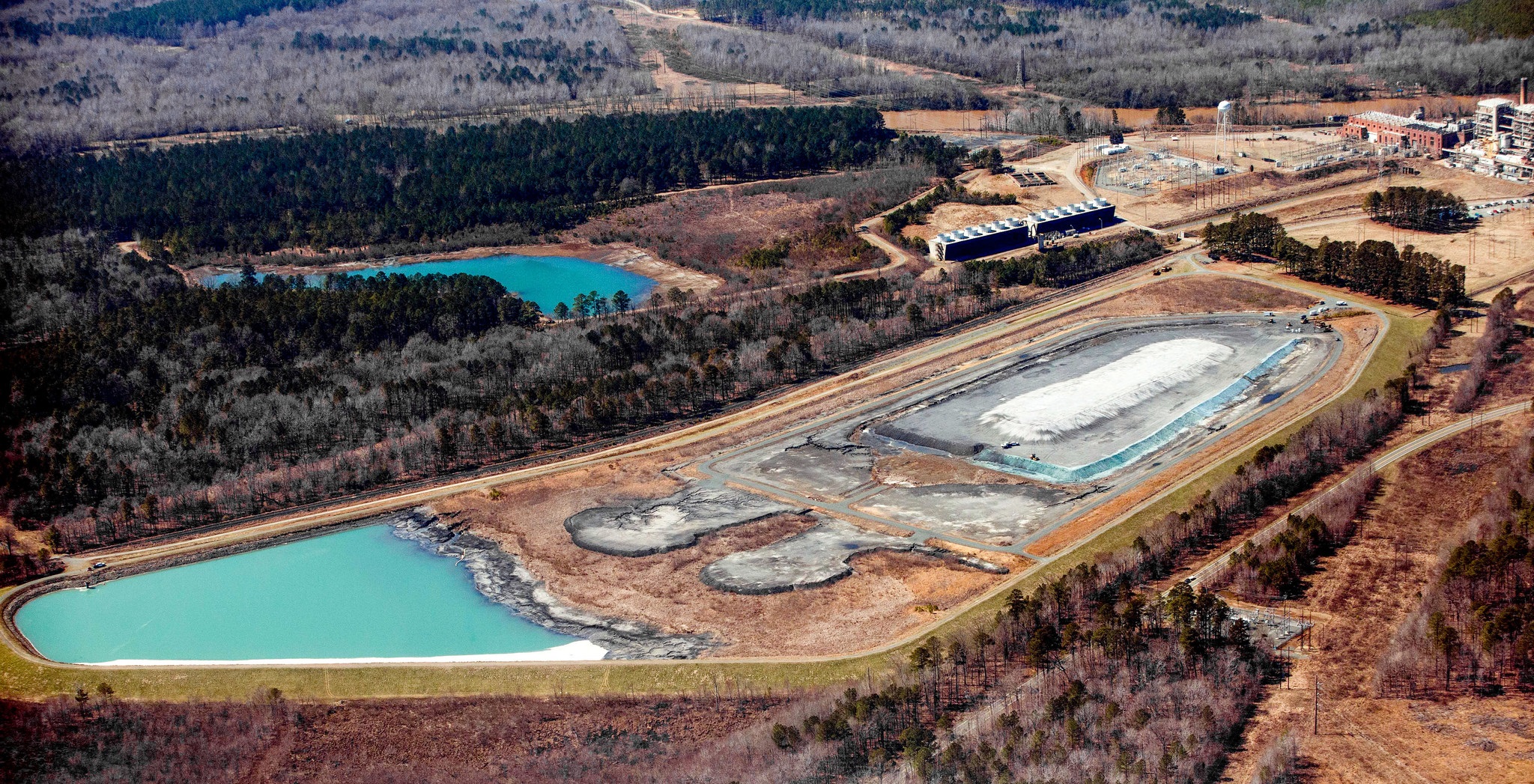
Coal ash ponds, like this one next to the Cape Fear River in North Carolina, have been recent targets of Clean Water Act lawsuits. Photo courtesy of Flickr/Creative Commons user Waterkeeper Alliance
By Brett Walton, Circle of Blue
The Lahaina Wastewater Reclamation Facility, on the Hawaiian island of Maui, pumps 3 million to 5 million gallons of treated sewage a day down four wells on its property. Once underground, the water does not stay put. It seeps through porous lava rock and then flows into the Pacific Ocean, a half-mile to the southwest.
If the treatment plant flushed its wastewater directly into the Pacific, through a pipe, it would need a Clean Water Act permit to do so. Such “point sources” are clearly regulated and the permit could be used as leverage to reduce nutrients in the wastewater. But the movement of pollutants through groundwater into a river, lake, or ocean is a legal grey zone. Groundwater, a state prerogative, is generally not covered by the landmark federal pollution law.
Yet, in this case, that is what the Ninth Circuit Court of Appeals determined. On February 1, the federal court upheld a lower court’s ruling that these discharges are indeed regulated by the Clean Water Act.
It was the second ruling in such a case in recent weeks. At the end of December, the U.S. District Court for the Eastern District of Kentucky, in a lawsuit involving pollution from a coal waste dump, reached the opposite conclusion, even though circumstances mirrored those in Maui. Arsenic, cadmium, selenium, and other heavy metals were leaching from the waste dump at the E.W. Brown power plant into groundwater, which carried the metals into a nearby lake where they ended up ingested by fish.
The two cases are part of a growing legal confrontation over the Clean Water Act. While the U.S. Environmental Protection Agency and the Army Corps of Engineers rewrite an Obama administration rule about the law’s applicability to wetlands, ponds, and seasonal rivers, green groups are taking a different tack in court, filing lawsuits that target instances in which groundwater channels pollutants from a waste pond, a well, or another site into rivers and lakes.
Legal experts say that the so-called “conduit theory” has far-reaching consequences for water law and policy, for preventing pollution, and for water and electric utilities, which may see their liability increase.
Broad application of the theory would “require many presently unregulated facilities and unpermitted discharges across all sectors of the economy and all corners of the state to obtain permits,” argue Michael Gerrard, a Columbia Law School professor, and Edward McTiernan, an attorney with Arnold and Porter Kaye Scholer. The theory could be a new valve for curtailing water pollution while also increasing the number of sites that are vulnerable to lawsuits.
Law Vs. Nature
At least half a dozen cases that make similar arguments about groundwater as a conduit are now in federal appeals court. Many, like the Kentucky lawsuit, which was brought by the Kentucky Waterways Alliance and the Sierra Club, aim to clamp down on coal ash ponds. These waste sites are also targets in cases in North Carolina, Tennessee, and Virginia. Other lawsuits arguing the conduit theory are directed at a pipeline spill in South Carolina and a sewage backup in New York.
The arguments in these cases address distinctions in the law that are not always present in nature. In the Maui case, no party disputes that wastewater enters the Pacific via groundwater; dye tests conducted by the University of Hawaii at Manoa proved that. What is in dispute is, under the Clean Water Act, whether that matters.
The act applies to point sources, which conventionally means a pipe sticking into a waterway. Nonpoint sources, on the other hand, are diffuse. A common example is the grime on a road that washes into a creek. It cannot be traced back to a single car.
Thomas Cmar, an Earthjustice attorney who represented Kentucky Waterways Alliance in its lawsuit, thinks that the act’s language on point sources is broad enough to include coal ash pits and other discrete sites that leak pollution into rivers via groundwater. That is what he argued unsuccessfully in the district case.
That argument, however, has scored in other courts. Because district courts are divided, the cases now being heard in appeals courts have particular importance. Recent rulings in Tennessee and Virginia have favored advocates of the conduit theory.
What is interesting about the Maui case is that the EPA filed a brief in 2016 supporting the conduit theory. The EPA claimed that sites that discharge to groundwater with a “direct hydrological connection” to a regulated waterway should be considered point sources.
The Ninth Circuit, however, did a bit of contortion in its ruling. The judges agreed with the EPA but not with its reasoning. They instead offered a slightly different definition, concluding that the connection must be “fairly traceable,” which is even broader.
Water utilities are nervous about the rulings. Smaller utilities operate sewage lagoons that could be targets. The National Association of Clean Water Agencies filed a brief in support of the County of Maui, which is a member of the organization. Amanda Waters, NACWA’s general counsel, argues that the Ninth Circuit’s ruling ignores the text of the Clean Water Act and confuses the qualifications of a point source.
Next Steps
In recent months, groundwater law has reached the U.S. Supreme Court. In November, the court decided not to hear an appeal from California water agencies over tribal groundwater rights. By denying the appeal, the court recognized that the Agua Caliente tribe has rights to the water beneath its reservation land, an action that could influence the legal claims for hundreds of tribes across the country.
Might the Supreme Court take up the conduit theory? Opinions vary. When appeals courts reach split decisions, the high court is more likely to step in with a resolution. Cmar thinks that the appeals courts will issue concurring opinions, but others point out that cases going back decades had contradictory outcomes.
Meanwhile, other lawsuits will proceed. Cmar told Circle of Blue that the setback in the Kentucky case will not derail Earthjustice’s pursuit of this legal strategy. “Not at all,” he said.
Kentucky Waterways Alliance and the Sierra Club appealed the ruling on January 26 to the Sixth Circuit Court of Appeals. The details of the case will look familiar to the Sixth Circuit judges — they are already considering a lawsuit against the Tennessee Valley Authority that makes the same argument about coal ash ponds.
In other jurisdictions, Earthjustice is ready to get back in the ring.
Earthjustice and Prairie Rivers Network gave notice on January 31 that they plan to sue Dynegy, an electric power company whose coal ash pits, they claim, are polluting the Middle Fork of the Vermilion River with heavy metals. The groups plan to argue that arsenic, chromium, manganese, nickel, and other metals are leaching from coal ash pits at the Vermilion Power Plant into groundwater, which is connected to the river.
Brett writes about agriculture, energy, infrastructure, and the politics and economics of water in the United States. He also writes the Federal Water Tap, Circle of Blue’s weekly digest of U.S. government water news. He is the winner of two Society of Environmental Journalists reporting awards, one of the top honors in American environmental journalism: first place for explanatory reporting for a series on septic system pollution in the United States(2016) and third place for beat reporting in a small market (2014). He received the Sierra Club’s Distinguished Service Award in 2018. Brett lives in Seattle, where he hikes the mountains and bakes pies. Contact Brett Walton

